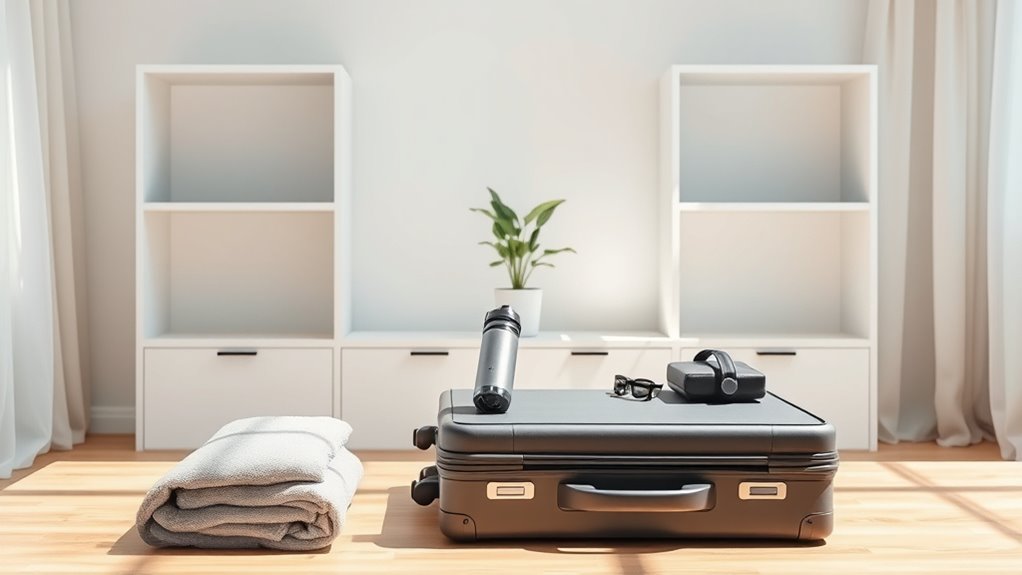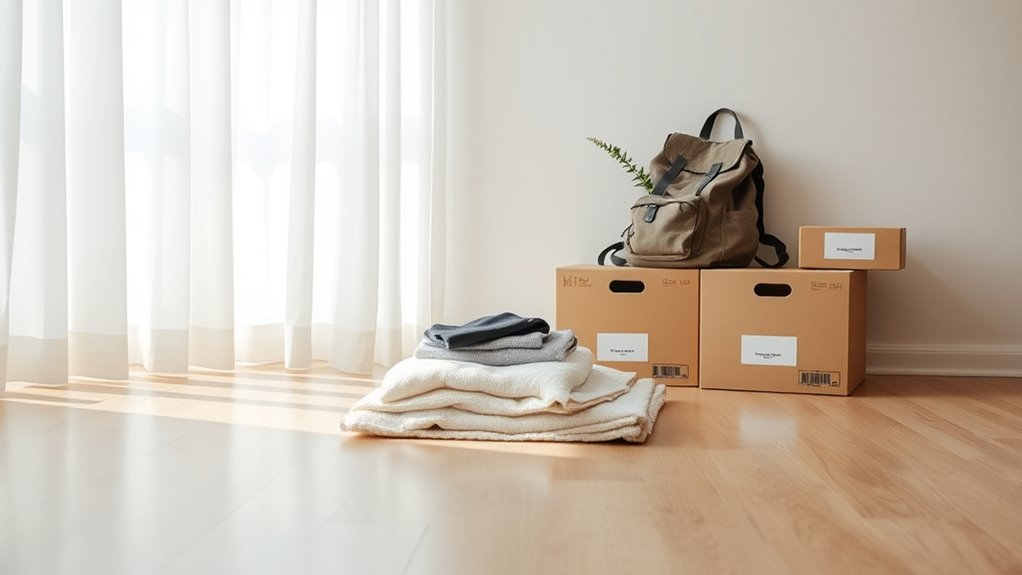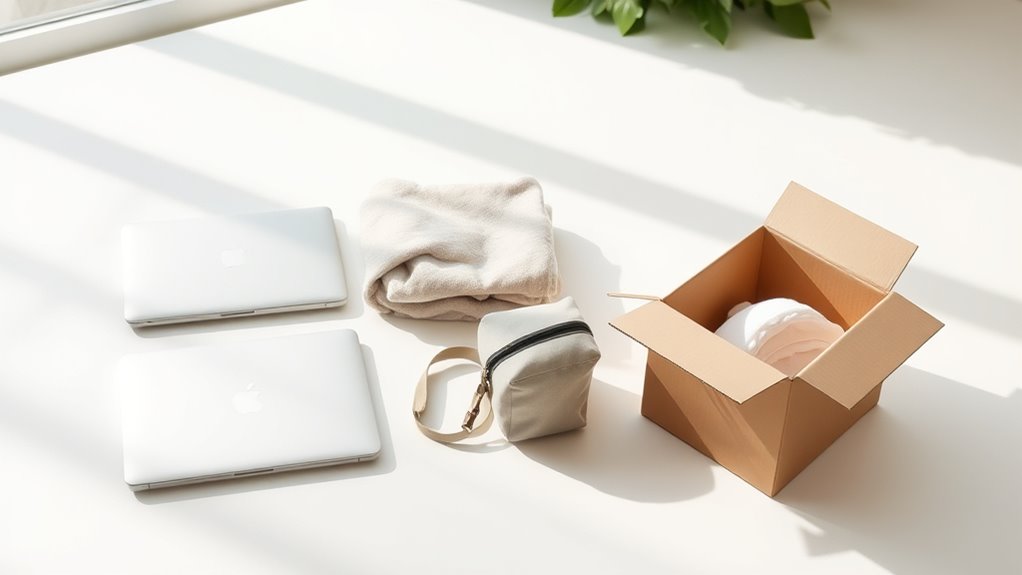To pack minimally for a clutter-free move, start by creating a detailed task list and budget. Focus on necessity and sentimental value when deciding what to keep. Gather essential packing supplies like boxes, tape, and labels. Use organizational techniques like labeling boxes by room and keeping an inventory. On moving day, designate a point person for coordination. These strategies will streamline your move, but there's more to explore for an even smoother transition.
Key Takeaways
- Prioritize essential items based on necessity, usage, and sentimental value to minimize what you pack.
- Use the 4-box method (keep, donate, sell, discard) to streamline your belongings for a clutter-free move.
- Gather quality packing supplies, including various-sized boxes, packing tape, and protective gear for fragile items.
- Clearly label each box by room and contents to simplify the unpacking process in your new space.
- Pack an essentials bag with necessary items for the first night to ensure a smooth transition after moving.
Planning and Preparation for a Minimalist Move

When you start planning for a minimalist move, it's crucial to begin well in advance to keep stress at bay.
Start by creating a detailed task list, breaking the moving process into smaller, manageable tasks with specific deadlines. Completing small tasks daily can prevent last-minute panic as the moving day approaches. Start early and plan ahead to allow for mindful decision-making about your belongings. Incorporating elements of senior living design can enhance the functionality of your new space, making it more comfortable and accessible.
Don't forget to budget early; this allows for adjustments if unexpected expenses arise.
As you select items to bring, focus on their necessity, usage, or sentimental value. Visualizing how your belongings will fit in the new space can help you make mindful decisions, ensuring you only carry what truly matters into your new life.
Embrace this opportunity for a fresh start!
Effective Decluttering Strategies

To effectively declutter before your move, start by breaking the process into manageable steps that make it feel less daunting.
Begin with small areas or tackle one room at a time to maintain focus. Use the 4-box method to sort items into categories: keep, donate, sell, and discard. If you find it hard to decide, create a "maybe" box and revisit it later. Regularly assessing and rotating items can help prevent clutter buildup in your new space.
Start with small areas or one room at a time, using the 4-box method to sort your belongings effectively.
Set a time limit for each decluttering session to keep your momentum going. Additionally, prioritize high-impact areas that need attention. Remember that a clean, simple home promotes peace and joy, making the effort worthwhile.
Regularly review your belongings and involve your family to make the process smoother. By following these strategies, you'll create a clutter-free environment that's ready for your new space. Embracing mindful decluttering will not only simplify your move but also contribute to a more sustainable lifestyle.
Essential Packing Supplies

As you prepare for your move, having the right packing supplies on hand can make the process smoother and more efficient.
Start with cardboard moving boxes in various sizes to fit your items. Secure these boxes with packing tape and use packing paper or bubble wrap to protect fragile belongings. For additional cushioning, consider packing peanuts or foam sheets. Additionally, consider using specialty packing supplies such as wardrobe boxes and dish boxes to ensure your clothing and glassware are packed safely. The use of protective gear like furniture covers and moving blankets can further safeguard your items during transit.
Don't forget protective gear like furniture covers, moving blankets, and mattress bags to keep your items safe from dust and damage.
Lastly, grab a set of labels and markers to clearly identify the contents of each box. With these essentials, you'll streamline your packing and ensure everything arrives at your new home intact.
Organizational Techniques for Packing

While packing for a move can feel overwhelming, employing effective organizational techniques can significantly ease the process.
Start by creating a comprehensive checklist to track tasks and ensure nothing's forgotten. A moving planner can help you manage timelines and responsibilities efficiently. Additionally, early planning for your move can help streamline the packing process and ensure that everything is organized. To create a cozy atmosphere in your new space, consider incorporating warm color palettes that promote relaxation.
Before you pack, declutter your space to reduce the number of items you need to move.
When it's time to pack, label boxes by room and content for easy unpacking. Utilize technology, like inventory apps, to keep track of what you've packed.
Consider color-coded labels for quick identification and maintain a consistent labeling system. These strategies will help you stay organized and make the moving experience smoother.
Efficient Packing Strategies

Packing efficiently can transform what feels like a daunting task into a more manageable process. Start by packing room-by-room to stay organized. Declutter your belongings and donate what you don't need, reducing the overall load. Use a variety of box sizes to accommodate different items, and protect fragile pieces with bubble wrap or linens. Clearly label each box with its contents and the destination room for easy unpacking later. Utilize space wisely by nesting smaller boxes inside larger ones. Repurpose items like suitcases for smaller belongings, and consider compression bags for bulky clothing. A minimalist mindset helps you focus on essentials, making packing streamlined and effective. Additionally, adopting sustainable building practices during your move can further enhance your commitment to a clutter-free lifestyle. Minimalist packing can also encourage a mindset shift towards simplicity, ultimately making your move simpler and less stressful.
Moving Day Tips for a Smooth Transition

Once you've organized your belongings and packed efficiently, moving day can still present its own set of challenges.
Designate a point person to oversee the process and answer any questions from movers. Load heavy items first for balanced weight distribution, placing fragile items last for their protection.
Keep everyone hydrated by providing water throughout the day, and encourage regular breaks to maintain energy levels. Additionally, ensure all necessary packing supplies are ready for moving day to avoid any last-minute stress.
Before the movers arrive, confirm all details with the moving company. Pack an essentials bag for the first night and label boxes clearly for easy unpacking.
Be present to communicate any specific handling instructions, and ensure the moving team is licensed and insured.
Following these tips will help ensure a smooth transition to your new home.
Frequently Asked Questions
How Do I Handle Sentimental Items During Decluttering?
When you're handling sentimental items during decluttering, start by sorting them into categories: keep, donate, sell, or discard.
Share stories behind these items to help detach emotional value.
Consider giving them a final use or take photos to preserve memories without keeping the physical objects.
Set boundaries with family about what they want, and regularly review your items to ensure they still hold meaning for you.
Embrace the memories within, not just the objects.
What Should I Do if I Run Out of Packing Supplies?
If you run out of packing supplies, don't worry; that's the perfect time to unleash your inner MacGyver!
Check local stores or borrow boxes from neighbors. You can even repurpose old towels as cushioning—who knew your laundry could be so useful?
If you're feeling crafty, create DIY packing materials from cardboard.
Embrace the chaos, and you might just invent a new packing trend that others will envy!
How Can I Involve My Family in the Packing Process?
To involve your family in the packing process, assign age-appropriate tasks to keep everyone engaged.
Turn it into a game by sorting items together, and use colorful stickers for a fun touch.
Encourage older kids to wrap fragile items and manage their own boxes.
Explain the move to reduce anxiety and let everyone choose essentials for the first night.
Lastly, create goals as a family to maintain motivation throughout the process.
What Are the Best Ways to Find a Reliable Moving Company?
Finding a reliable moving company is like navigating a labyrinth; you need a clear map to avoid dead ends.
Start by scouring reviews on Google and Yelp, and don't shy away from asking friends for recommendations. Check for certifications and ensure they're licensed and insured.
Request in-home estimates to get accurate pricing. Finally, trust your instincts—if something feels off, keep searching until you find the perfect fit for your moving adventure.
How Can I Ensure My New Home Remains Clutter-Free Long-Term?
To ensure your new home stays clutter-free long-term, start with daily maintenance.
Spend a few minutes each day tidying up and involve everyone in your household to share responsibilities.
Conduct regular reviews of your belongings to assess their usefulness.
Create designated clutter-free zones and practice mindful consumption by questioning new purchases.
Conclusion
By embracing a minimalist approach to your move, you'll not only simplify the packing process but also create a fresh start in your new space. For instance, when Sarah downsized from a three-bedroom home to a cozy apartment, she donated 50% of her belongings. This not only lightened her load but also made her new place feel more open and inviting. Remember, a clutter-free move leads to a clutter-free life, allowing you to focus on what truly matters.









